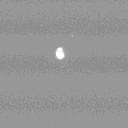Pallene (moon)
|
Pallene in September 2010 | |
| Discovery | |
|---|---|
| Discovered by |
Voyager 2 (first discovery) Cassini Imaging Team[1] |
| Discovery date | June 1, 2004 (second discovery by Cassini-Huygens) |
| Designations | |
|
Saturn XXXIII S/1981 S 14 (first discovery) S/2004 S 2 (second discovery) | |
| Orbital characteristics [2] | |
| Epoch 20 June, 2004 (JD 2453177.5) | |
| 212,280 ± 5 km | |
| Eccentricity | 0.0040 |
| 1.153745829 d [3] | |
| Inclination | 0.1810 ± 0.0014° (to Saturn's equator) |
| Satellite of | Saturn |
| Physical characteristics | |
| Dimensions | 2.88 × 2.08 × 1.84±0.07[4] |
Mean radius | 2.22±0.07 km[4] |
Mean density |
0.25+0.09 −0.06 g/cm3[4] |
| synchronous | |
| zero | |
|
| |
Pallene (/pəˈliːniː/ pə-LEE-nee; Greek: Παλλήνη) is a very small natural satellite of Saturn. It is one of three small moons known as the Alkyonides that lie between the orbits of the larger Mimas and Enceladus. It is also designated as Saturn XXXIII (33).
Discovery

Pallene was discovered by the Cassini Imaging Team in 2004, during the Cassini–Huygens mission.[5][6] It was given the temporary designation S/2004 S 2. In 2005, the name Pallene was provisionally approved by the IAU Division III Working Group for Planetary System Nomenclature,[7] and was ratified at the IAU General Assembly in 2006. The name refers to Pallene, one of the Alkyonides, the seven beautiful daughters of the giant Alkyoneus.
After the discovery in 2004, it was realized that Pallene had been first photographed on August 23, 1981, by the space probe Voyager 2. It had appeared in a single photograph and had been provisionally named S/1981 S 14 and estimated to orbit 200,000 km from Saturn.[8] Because it had not been visible in other images, it had not been possible to compute its orbit at the time, but recent comparisons have shown it to match Pallene's orbit.[2]
Orbital characteristics
Pallene is visibly affected by a perturbing mean-longitude resonance with the much larger Enceladus, although this effect is not as large as Mimas's perturbations on Methone. The perturbations cause Pallene's osculating orbital elements to vary with an amplitude of about 4 km in semi-major axis, and 0.02° in longitude (corresponding to about 75 km). Eccentricity also changes on various timescales between 0.002 and 0.006, and inclination between about 0.178° and 0.184°.[2]
Ring
In 2006, images taken in forward-scattered light by the Cassini spacecraft enabled the Cassini Imaging Team to discover a faint dust ring around Saturn that shares Pallene's orbit, now named the Pallene Ring.[9][10] The ring has a radial extent of about 2,500 km. Its source is particles blasted off Pallene's surface by meteoroid impacts, which then form a diffuse ring around its orbital path.[11][12]
Exploration
The Cassini spacecraft, which is currently studying Saturn and its moons, performed a fly-by of Pallene on 16 October 2010, at a distance of 36,000 kilometeres (22,000 miles).
References
Further reading
- "Cassini Imaging Science Team". Cassini Imaging Central Laboratory for OPerationS. Retrieved 2012-01-01.
- "Moonmade Rings". Cassini Imaging Central Laboratory for OPerationS. October 11, 2006. Retrieved 2012-01-01.
- Green, Daniel W. E. (April 14, 1995). "Possible Satellites of Saturn". IAU Circular. 6162. Retrieved 2012-01-01.
- Green, Daniel W. E. (August 16, 2004). "S/2004 S 1 and S/2004 S 2" (discovery). IAU Circular. 8389. Retrieved 2012-01-01.
- Green, Daniel W. E. (January 21, 2005). "S/2004 S 1 and S/2004 S 2" (naming the moon). IAU Circular. 8471. Retrieved 2012-01-01.
- Green, Daniel W. E. (October 11, 2006). "Rings of Saturn (R/2006 S 1, R/2006 S 2, R/2006 S 3, R/2006 S 4)". IAU Circular. 8759. Retrieved 2012-01-01.
- Hedman, M. M.; Murray, C. D.; Cooper, N. J.; Tiscareno, M. S.; Beurle, K.; Evans, M. W.; Burns, J. A. (2008-11-25). "Three tenuous rings/arcs for three tiny moons". Icarus. 199 (2): 378–386. Bibcode:2009Icar..199..378H. doi:10.1016/j.icarus.2008.11.001. ISSN 0019-1035.
- "NASA Finds Saturn's Moons May Be Creating New Rings". Cassini Solstice Mission. JPL/NASA. October 11, 2006. Retrieved 2012-01-01.
- Porco, C. C.; Baker, E.; Barbara, J.; Beurle, K.; Brahic, A.; Burns, J. A.; Charnoz, S.; Cooper, N.; Dawson, D. D.; Del Genio, A. D.; Denk, T.; Dones, L.; Dyudina, U.; Evans, M. W.; Giese, B.; Grazier, K.; Helfenstein, P.; Ingersoll, A. P.; Jacobson, R. A.; Johnson, T. V.; McEwen, A.; Murray, C. D.; Neukum, G.; Owen, W. M.; Perry, J.; Roatsch, T.; Spitale, J.; Squyres, S.; Thomas, P.; Tiscareno, M. (February 25, 2005). "Cassini Imaging Science: Initial Results on Saturn's Rings and Small Satellites". Science. 307 (5713): 1226–1236. doi:10.1126/science.1108056. PMID 15731439.
- Spitale, J. N.; Jacobson, R. A.; Porco, C. C.; Owen, W. M., Jr. (2006). "The orbits of Saturn's small satellites derived from combined historic and Cassini imaging observations" (PDF). The Astronomical Journal. 132 (2): 692–710. Bibcode:2006AJ....132..692S. doi:10.1086/505206.
- Thomas, P. C. (July 2010). "Sizes, shapes, and derived properties of the saturnian satellites after the Cassini nominal mission" (PDF). Icarus. 208 (1): 395–401. Bibcode:2010Icar..208..395T. doi:10.1016/j.icarus.2010.01.025.
- Thomas, P. C.; Burns, J. A.; Tiscareno, M. S.; Hedman, M. M.; et al. (2013). "Saturn's Mysterious Arc-Embedded Moons: Recycled Fluff?" (PDF). 44th Lunar and Planetary Science Conference. p. 1598. Retrieved 2013-05-21.
External links
 Media related to Pallene at Wikimedia Commons
Media related to Pallene at Wikimedia Commons- Pallene Profile by NASA's Solar System Exploration
